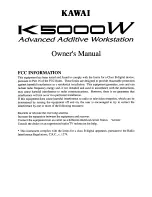
Appendix C
Advanced Hardware Configuration Settings
VXI-1394 Interface for Windows NT/98
C-4
www.ni.com
When the VXI-1394 is installed in Slot 0, it becomes the VXIbus System
Controller. In this role, it has VXIbus Data Transfer Bus Arbiter circuitry
that accepts bus requests on all four VXIbus request levels, prioritizes the
requests, and grants the bus to the highest priority requester. As VXIbus
System Controller, the VXI-1394 also uses an onboard 16 MHz oscillator
to drive the 16 MHz VXIbus system clock.
As required by the VXIbus specification, the VXI-1394 drives the 10 MHz
signal CLK10 on a differential ECL output when installed in Slot 0. When
not installed in Slot 0, the VXI-1394 only receives the CLK10 signal.
Configuration EEPROM
The VXI-1394 has an onboard EEPROM, which stores default register
values that are loaded at power-on. The EEPROM is divided into
two halves—a factory-configuration half, and a user-configuration half.
Both halves were factory configured with the same configuration values so
you can modify the user-configurable half, while the factory-configured
half stores a back-up of the default settings.
The Load Factory switch (switch S7) causes the VXI-1394 to boot off the
factory-configured half instead of the user-modified settings. This is useful
in the event that the user-configured half of the EEPROM becomes
corrupted in such a way that the VXI-1394 boots to an unusable state.
Figure C-3 shows the configuration settings for EEPROM operation.
Figure C-3.
EEPROM Operation
Y
N
LOAD FACTORY
Y
N
LOAD FACTORY
SLOT0
AUTO
A. Boot from User
Configuration (Default)
Y
N
LOAD FACTORY
SLOT0
AUTO
B. Boot from Factory
Configuration
NON-
SLOT0
NON-
SLOT0
S7
W1
S7
W1
















































